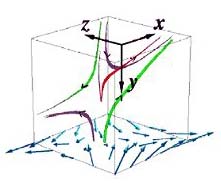
Understanding the timed messages within cells could lead to new medical treatments
Researchers from The Johns Hopkins University and other institutions have discovered a biochemical “clock” that appears to play a crucial role in the way information is sent from the surface of a cell to its nucleus. These messages can cause the cell to thrive or commit suicide, and manipulating them could lead to new treatments for cancer and other diseases, the researchers say.
The findings,

Like rapidly flowing gases and liquids, magnetically confined plasmas in tokamaks and related fusion devices exhibit a high degree of turbulence, which can generally destroy the optimal conditions for producing fusion energy. In a deeply encouraging new result, scientists have experimentally confirmed that turbulence can actually limit its own ability to wreak havoc.
Researchers at the DIII-D tokamak at General Atomics have discovered that turbulence generates its own flows that act as a sel

Doughnuts of plasma can be coaxed into configurations with hollow current rings, providing practical advantages over conventional “filled doughnut” shapes. Simulations suggest they will allow faster turn-on and greater efficiency of future nuclear fusion power plants.
Toroidal tokamaks, doughnut-shaped experimental fusion reactors, use a complex system of magnetic fields to hold a plasma together. Electrical currents flowing in the plasma itself are essential for making the internal magneti

In work that promises new insights into the cosmos and fusion-energy production alike, physicists have reported they have made the first three-dimensional laboratory measurements of magnetic reconnection, the main process by which magnetic fields release energy in the universe.
Magnetic reconnection is the phenomenon in which magnetic energy in a plasma is rapidly converted to heat and jets of energetic particles. This process is thought to heat the solar corona, the outer atmosphere of the

Working toward the vision of generating clean energy from nuclear fusion, researchers have successfully imploded fuel capsules by bombarding them with intense x-rays. The results show that the process generates significant fusion and that the implosion method looks capable of generating large-scale energy production.
The process works by bombarding two millimeter (about 1/16th inch) fuel capsules with intense x-rays from Sandia National Laboratories Z-pinch machine. The x-rays, impacting fro

Recent experiments by Sandia National Laboratories researcher Gary Harms and his team are using a new Labs-built reactor to provide benchmarks showing that spent nuclear fuel — uranium that has been used as fuel at a nuclear power plant — is considerably less reactive than the original fresh fuel. This could mean significant savings in the eventual safe transport, storage, and disposal of nuclear waste.
“The conservative view has always been to treat spent fuel like it just came out of the

– new calculation confirms standard model of particle physics. Contribution of hadronic vacuum polarization determined with unprecedented accuracy. The magnetic moment of the muon is an important precision parameter for…
Technique may prevent formation of unwanted waves that siphon off needed energy. Heating plasma to the ultra-high temperatures needed for fusion reactions requires more than turning the dial on a…

An international team of astronomers, led by researchers from the Astronomical Observatory of the University of Warsaw, have identified a new class of cosmic X-ray sources. The findings have been…

How deubiquitinases USP53 and USP54 cleave long polyubiquitin chains and how the former is linked to liver disease in children. Deubiquitinases (DUBs) are enzymes used by cells to trim protein…

Conceptual blueprint to analyze experimental catalyst data. Machine learning (ML) models have recently become popular in the field of heterogeneous catalyst design. The inherent complexity of the interactions between catalyst…

Antibody that Neutralizes Inhibitory Factors Involved in Nerve Regeneration Leads to Enhanced Motor Function after Acute Spinal Cord Injury. Researchers at 13 clinics in Germany, Switzerland, the Czech Republic and…

How simulations help manufacturing of modern displays. Modern materials must be recyclable and sustainable. Consumer electronics is no exception, with organic light-emitting diodes (OLEDs) taking over modern televisions and portable…

“Neurons that fire together, wire together” describes the neural plasticity seen in human brains, but neurons grown in a dish don’t seem to follow these rules. Neurons that are cultured…

The quest for sustainable energy solutions has been a major focus of scientific research for decades. Solar energy, a clean and renewable source, has emerged as a promising alternative to…

With a processing speed a billion times faster than nature, chip-based laser neuron could help advance AI tasks such as pattern recognition and sequence prediction. Researchers have developed a laser-based…

New technology could remotely identify various types of plastics, offering a valuable tool for future monitoring and analysis of oceanic plastic pollution. Researchers have developed a new hyperspectral Raman imaging…

Artificial Intelligence (AI) has established a strong presence across industries, large and small. The “VoBaKI” research project has empowered small and medium-sized enterprises (SMEs) with an innovative tool to independently…